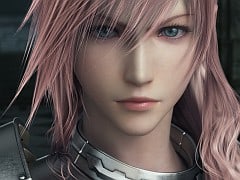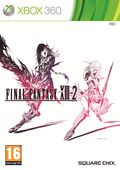You can trust VideoGamer. Our team of gaming experts spend hours testing and reviewing the latest games, to ensure you're reading the most comprehensive guide possible. Rest assured, all imagery and advice is unique and original. Check out how we test and review games here
What’s in a name? In the case of Final Fantasy XIII-2, the answer is quite a lot, actually. Consider it. Say it out loud. Final Fantasy XIII-2 is a name that prompts players to stack a laundry list of questions.
Unlike other Final Fantasy games – whose worlds, stories and characters have no connection with their numerical forebears – Final Fantasy XIII-2 continues on from the storyline of Final Fantasy XIII, a game that took players the better part of 48 hours to finish and then rinse completely for extra content. Without having played its predecessor, diving into the plot of FFXIII-2 is like starting The Wire halfway through its third season – you won’t know what the hell is going on.
It doesn’t help that FFXIII was divisive. While the game has shifted well over 2 million copies, there’s been a vocal backlash against its linear structure, with many fans complaining that things didn’t really get going until the last few stages. So there are a couple of conundrums: If you’re new to this genre or series, is Final Fantasy XIII-2 a good entry point? And if you’re a long-time fan of the series burned by XIII, should you give its sequel a wide berth?
As is the way with Square Enix’s flagship JRPG series, the answers are rather complex. XIII-2 is every bit as eccentric as its predecessor and demands complete surrender from anyone hoping to appreciate its unique delights. Square Enix, it seems, has also taken quite a bit of the XIII’s negative feedback to heart, producing a game that feels both streamlined and filled out at the same time.
FF XIII-2 begins with Lightning staring out over the beautiful vista of Valhalla, before being attacked by a man named Caius wielding a sword roughly the same size as a tree because, well, that’s the sort of thing that happens at the beginning of a Final Fantasy game.
During their battle, which wrecks large sections of Valhalla, a man named Noel Kreiss arrives. Lightning charges him with finding her sister, Serah, and then sends him back through time with a Moogle to help him. Noel and Serah join forces and their journey takes them through time and space, visiting different parts of Cocoon and Pulse in various ages.
Along the way, they find out that they can alter time so that Lightning can finally reunite with her sister, and the age from which Noel hails – which is 700 years in the future – need not herald the end of humankind as we know it. Handy.
If all of this sounds a bit difficult to follow, well then… that’s because it is. The game’s story shunts its protagonists back and forth across the space/time continuum, mentioning anomalies like paradoxes, broken timelines and alternate futures, but the overall plot ends up being quite disposable. The characters are also pretty flat and the dialogue uniformly awful, making the game’s protagonists and story difficult to actually care about. There are a couple of instances – one involving the revelation that someone is remotely hacking Cocoon’s timeline – that initially sound promising, but they ultimately don’t add up to much.
The game’s breathtaking presentation, however, almost makes up for this lack of compelling narrative. Whatever criticisms one may level at XIII-2, only the most churlish could fault its visuals and soundtrack. Working from a slightly lighter palette than XIII, the developers have once again crafted a series of locales that stand as some of the most beautiful and unique vistas ever presented in the medium.
From the lush, overgrown jungles of Sunleth Waterscape to the cyber-noir metropolis of Academia and the broken world of Oerba, whose landscape is shattering off into the cosmos, the worlds of FFXIII-2 are evidence of formidable creativity and imagination. The character models, for the most part, are also superb; Noel, Serah and nearly everyone else – especially the Moogle – may be painful to listen to, but they look absolutely sublime. Attention is paid to everything from the odd bit of wind tossing their immaculately preened hair, to a thin layer of powder settling on their shoulders as they make their way through the snow-tipped Vile Peaks.
The soundtrack follows the mood almost perfectly. The music is by turns, restrained and mournful, or jaunty and vibrant – but is hardly ever intrusive. The only glaring missteps are during boss battles, which generally sound like vintage Slayer being channelled by a techno band from 1997.
Still, the production values were never a problem for the critics of FFXIII; their main gripe was the game’s rigid linearity. Their complaints have obviously had an effect, as the linear structure of XIII has been stripped out – barring an on-rails battle at the very beginning of the game – and replaced with one that feels more open-ended, mapped out over a series of ages the player can freely explore. These aren’t true open-world maps but, with one or two exceptions, a series of corridors filled with NPCs, some of whom offer side-quests and some of whom offer banal lines of dialogue.
While there are massive time gates dotted around the environments, players can also travel to any age previously visited by hitting the start button. They can also save their game whenever and wherever they want – if you’ve ever played an FF game before, you’ll know what a boon that is.
Players unlock the game’s various ages by having Noel and Serah track down artefacts; these are either earned for completing quests, or they are concealed somewhere in the map and sniffed out with the Moogle. There’s also shop in every age, which always takes the form of a woman dressed as a Chocobo. Speaking of Chocobos, not only are they available to ride in most areas, but players can also gamble on them in the casino-themed world of Serendipity. This serves as a kind of in-game Vegas; it has nothing at all to do with the story and seems to exist mainly for players to kick back and earn some Gil on the races or slots.
Square Enix has also improved the Active Time Battle (ATB) system for the game’s combat. Players can now switch leaders mid-battle, paradigm shifts don’t pause the action with pointless animations and the death of the team leader doesn’t signal the end of the fight. Occasionally, usually during boss battles, players also have to complete a QTE sequence that occurs in the middle of the action.
Players aren’t restricted in how or when they level up their characters. Nor are there any roles that are off limits; both Noel and Serah can unlock any combat role from Ravager to Commando to Medic and so forth, although it should be pointed out that Noel gravitates towards certain roles better than Serah does, and vice versa. Specialising early helps, although it’s worth unlocking a couple of roles for each character – one defensive and one attacking – at the earliest opportunity.
Players can also press gang monsters into their team from quite early on in the game. Monsters have only one role in combat, but players can switch monsters mid-battle, giving Noel and Serah an array of roles they can use as a third option. Monsters have their own special Feral Attack, powered by a meter they fill in battle; once deployed it can prove to be a timely edge. One example of this is a monster in the Ravager role whose Feral Attack can fill an enemy’s Stagger meter quite quickly. Unlike the two main protagonists, who the player upgrades with Crystarium Points – dropped with more frequency in XIII-2 than they were in XIII – monsters are upgraded with parts that are picked up on the battlefield or bought in the shop.
By now, it should be apparent that Final Fantasy XIII-2 occupies a space that will satisfy hardliners without ejecting any of the newcomers that were roped in by its predecessor. It corrects a lot of the issues that fans of the series had with Final Fantasy XIII without initiating a complete sea change, but that’s as far as its concessions go. It’s not a watershed for the genre, nor is it a return to the franchise’s glory days. This is a game for admirers (however grudging) of Final Fantasy XIII and JRPG fans in general. But then, if you made it to the end of this review, chances are, you knew that already…
Version Tested: Xbox 360

/https://oimg.videogamer.com/images/db5f/final_fantasy_132_292.jpg)






